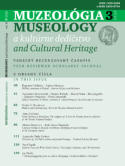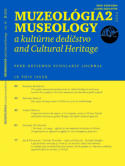

MUZEOLÓGIA
MUSEOLOGY
a kultúrne dedičstvo
and Cultural Heritage

News
Journal Muzeológia a
kultúrne dedičstvo -
Museology and Cultural
Heritage:
SJR 2024: 0,424 (Q1)
Museology SJR rank: 8/83 (Q1) Conservation SJR rank: 11/103 (Q1)JIF WoS 2024: 0,7
JCI WoS 2024: 1,25, Q1 ESCI: 40/408 (Q1)New issue
Muzeológia a kultúrne
dedičstvo 2/2025
online New volume Studia Museologica Slovaca, vol. 8 (2024) online New volume Populačné štúdie Slovenska 18 (2025) onlineNew book
L. Jagošová a P. Tišliar (eds.). Kapitoly z dějin uměleckoprůmyslového muzejnictví (2025) online
Contents 2/2022
Title: The specific museum presentation forms of cultural heritage in rural areas, based on the
example of the Hont ecomusuem and educational public footpath
Abstract: This study focuses on forms of museological presentation for the mediation of natural, cultural, historic and social values,
with specific reference to ecomuseums and educational public footpaths. The object of the study is to characterise these forms and on
the basis of real examples, in order to highlight opportunities in the field of museological communication that lead away from the
traditional interpretation of forms focused on the object, towards contemporary flexible modes of communication directed towards the
experience within its context. It also explores the utilisation of such approaches for the development and promotion of the locality and
its attractions. The subjects of the research are the ecomuseum and educational public footpath in the village of Hrušov. These
features are identified with the locality and accentuate specific aspects of its cultural heritage, presenting them to visitors. The study is
the result of ethnological research undertaken periodically since 2017 and it represents an introductory probe into the chosen area.
Author: Koštialová Katarína
Publication order reference: Matej Bel University in Banská Bystrica, Faculty of Arts, Department of Social Studies and Ethnology,
Tajovského 40, 974 01 Banská Bystrica, Slovakia, e-mail: katarina.kostialova@umb.sk, https://orcid.org/0000-0002-3573-9353
Source: Muzeológia a kultúrne dedičstvo, year: 2022, vol.: 10, number: 2, pages: 5-22.
Key words: ecomuseums, educational public footpath, natural and cultural heritage, tourism, Hrušov
Language: English
online full-text PDF
DOI: 10.46284/mkd.2022.10.2.1
Title: Pipe organ and organ music in Poland as a part of world heritage
Abstract: The pipe organ, as a musical instrument and an important object of cultural heritage, has been gaining increasing interest
from the international community in recent years. This paper aims at examining the possibilities of preserving organs and organ music
in Poland in an international context. As part of the study, an analysis of UNESCO lists was conducted. Furthermore, the organ-
building assets in Poland and tourist products developed on their basis (including cultural trails dedicated to organs and organ
museums) were studied. Attention was also drawn to other sites and forms of the organ of possible interest to tourists, and to the
functioning of organ festivals during the COVID-19 pandemic and virtual organ projects implemented in that period. In addition, public
awareness concerning the organ in Poland and Europe as well as organ festivals and other associated tourist products was examined.
Finally, actions aimed at preserving Poland’s organ heritage were proposed with reference to practices in other European countries. It
was concluded that one of the possible ways to integrate the conservation of organ heritage is a comprehensive approach through the
landscape. Organs and their music also form a part of the local landscape, both as landforms reminiscent of the instruments and as
artistic installations and sounds, shaping a sense of local and regional identity. It is also very important to engage in cross-border
cooperation (including an exchange of good practices) and educational projects with regard to the safeguarding of organ heritage.
Author: Bernat Sebastian
Publication order reference: Institute of Socio-Economic Geography and Spatial Management, Maria Curie-Sklodowska University
in Lublin, Poland, e-mail: sebastian.bernat@mail.umcs.pl, orcid.org/0000-0001-7224-6534
Source: Muzeológia a kultúrne dedičstvo, year: 2022, vol.: 10, number: 1, pages: 23-42.
Keywords: sound heritage, cultural landscape, UNESCO, COVID-19, sound tourism
Language: English
online full-text PDF
DOI: 10.46284/mkd.2022.10.2.2
Title: Comparison between the impacts of the irrigation systems of Persian Safavid and Italian
Renaissance gardens through a descriptive-historical approach
Abstract: This article is based on the comparison of the irrigation systems in gardens of two simultaneous periods but formed in two
different lands, Italian Renaissance gardens and Persian Safavid gardens. The studies that have been done so far do not explicitly
mention the relationship between these two gardens, and this research can be a starting point for referring to historical studies and
discovering the possible connections and their effects on each other. The research is qualitative with an interpretive historical
approach that seeks to investigate the origins of the irrigation systems of Persian and Italian Villa gardens in the Renaissance period.
Methodologically, this study carries out a literature review and case studies by identifying sources in historical bibliographies and
archives and by observation in Persian and Italian Renaissance gardens. The result shows some crucial changes occurred to Italian
gardens which transformed the form and figure of the gardens. The first and most important one was the creation of running water.
According to historical records, two important events are recognised for their impact on the irrigation system: the first was the influence
between gardens within and after the Crusader period and the second was Navagaro letters and the impact of Islamic Andalusian
gardens on Italian Renaissance gardens.
Author: Okhovat Hanie
Publication order reference: University of Tehran, College of Farabi, Qom, Iran, e-mail: h.okhovat@ut.ac.ir, https://orcid.org/0000-
0002-9534-1339
Source: Muzeológia a kultúrne dedičstvo, year: 2022, vol.: 10, number: 2, pages: 43-60.
Keywords: Irrigation system, Italian Renaissance gardens, Persian Safavid gardens
Language: English
online full-text PDF
DOI: 10.46284/mkd.2022.10.2.3
Title: Vita brevis, Ars longa – applied art and modernist architecture in Poland: Transformation of
approach to applied art and contemporary protection
Abstract: The main aim of the present paper is to present the latest achievements in the process of protection of the applied art which
was a part of post 1950s architecture in Poland. During the period 1945–1990 many buildings were adorned with different applied art
forms: sgraffito, wall paintings, mosaics and other art techniques. The research focuses on the transformation of the society’s
approach to applied art after a period of neglect and different forms of protection. In many cases applied art forms like mosaics and
ceramic artworks became longer lasting elements than the architecture which they originally adorned. After the demolition of modernist
constructions, artworks are frequently transferred to new architecture. That process proves that vita (architecturae) brevis, ars longa.
Author: Wróblewski Sebastian
Publication order reference: Wrocław University of Science and Technology, Faculty of Architecture ul. B. Prusa 53/55, 50- 317
Wrocław, Poland, e-mail: sebastian.wroblewski@pwr.edu.pl, https://orcid.org/0000-0002-2574-8395
Source: Muzeológia a kultúrne dedičstvo, year: 2022, vol.: 10, number: 2, pages: 61-76.
Keywords: architecture, applied art, modernism, art, mosaic
Language: English
online full-text PDF
DOI: 10.46284/mkd.2021.10.2.4
Title: Legal protection and safety of works of art and other objects with historical or scientific value
borrowed from other countries for the purpose of temporary exhibitions organised within the territory
of Poland
Abstract: The article presents issues involving legal protection of borrowed works of art designated for temporary exhibitions outside
the territory of their country of origin, which have frequently constituted the most crucial elements of national heritage of that country.
Moreover, the mechanisms and regulations applied in the scope of insurance covering works of art and other objects with historical or
scientific value which formed part of exhibitions organised by museums worldwide have been portrayed. The article presents
experiences and solutions applied in this regard in Poland further to specifying international legal regulations that refer to the
discussed issue.
Authors: Dworzecki Jacek; Nowicka Izabela; Urbanek Andrzej; Szkurłat Izabela
Publication order reference: Military University of the Land Forces in Wroclaw, Academy of the Police Force in Bratislava, e-mail:
jacekdworzecki@o2.pl , https://orcid.org/0000-0002-9357-5713, Military University of the Land Forces in Wroclaw , e-mail:
izabela.nowicka@awl.edu.pl , https://orcid.org/0000-0001-8974-0803, Pomeranian University in Slupsk , e-mail:
andrzej.urbanek@apsl.edu.pl , https://orcid.org/0000-0003-0667-4068, Pomeranian University in Slupsk ; e-mail:
izabela.szkurlat@apsl.edu.pl ; https://orcid.org/0000-0001-6320-8421
Source: Muzeológia a kultúrne dedičstvo, year: 2022, vol.: 10, number: 2, pages: 77-88.
Keywords: collections mobility, collections in transfer, museum, legal protection of works of art
Language: English
online full-text PDF
DOI: 10.46284/mkd.2022.10.2.5
Articles (Abstracts)

Full-text version
DOI:10.46284/mkd.2022.10.2.0
ISSN 1339-2204
eISSN 2453-9759
Vol. 10 (2022), No. Is. 2



























